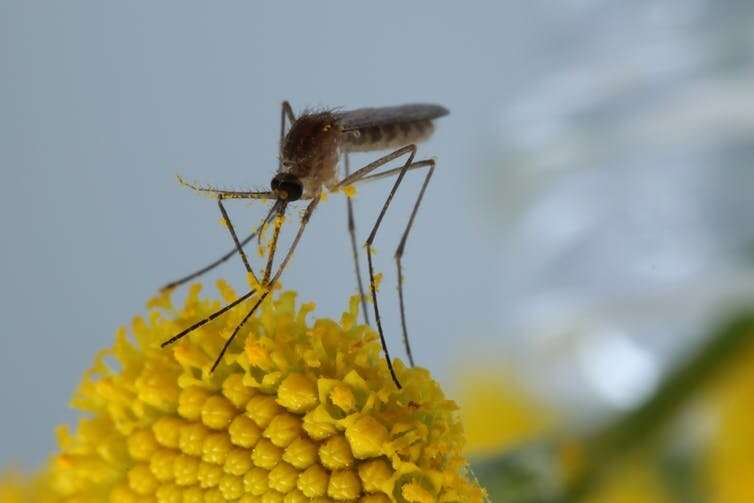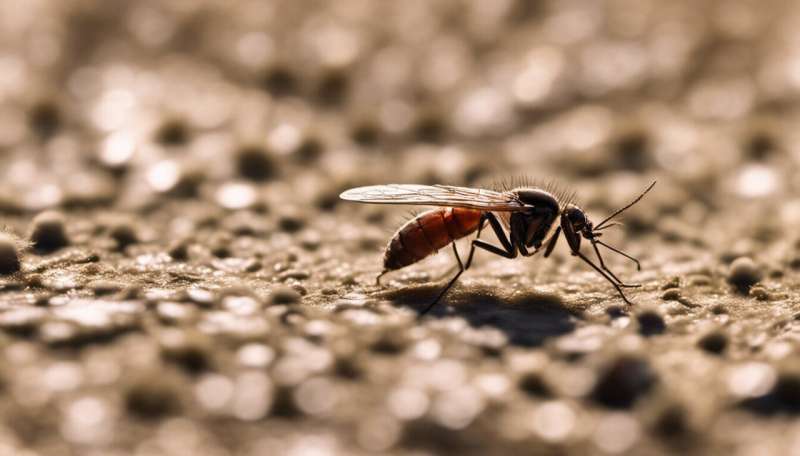The bizarre and ecologically important hidden lives of mosquitoes

Mosquitoes. Hordes of them, buzzing in your ear and biting incessantly, a maddening nuisance without equal. And not to mention the devastating health impacts caused by malaria, Zika virus and other pathogens they spread.
But mosquitoes have a whole other life that doesn't involve biting us; it revolves around their ecological interactions with plants.
We often view mosquitoes as bloodsuckers that do nothing but make our lives miserable. However, mosquitoes do have ecological functions. From pollination to ant puke, the secret life of mosquitoes is both bizarre and ecologically important.
Mosquitoes have many functions in the ecosystem that are overlooked. Indiscriminate mass elimination of mosquitoes would impact everything from pollination to biomass transfer to food webs.
Mosquitoes that pollinate
There are about , many of which want nothing to do with biting humans or any other animal. Even in species that bite, it is only the females that do so and just to develop their eggs.
The fundamental food of all adult mosquitoes is . In the process of looking for nectar, mosquitoes pollinate many of the flowers they visit —.
Mosquito pollination is likely far more common than we realize. There is evidence that mosquitoes function as in some plant families, and there are many .
Mosquito pollination was observed as far back as the . Mosquito pollination is hard to see, as most mosquitoes visit flowers near or after dusk and human presence disturbs mosquitoes from nearby flowers. In the Arctic, .
Mosquito evolution
The connection between mosquitoes and flowers is ancient and has likely had a strong influence on mosquito evolution. Genetic evidence supports a . Mosquito scales have been found in .
Mosquitoes locate flowers by a variety of cues including odour and vision, and recent research has discovered that . One interpretation of this is that to mosquitoes, some flowers may smell like humans, possibly indicating the evolutionary origins of why some mosquitoes take blood.
Sourcing honeydew
While less ecologically important than pollination, mosquitoes also consume plant sugar that has been processed by other insects.
Plant-sucking insects such as aphids excrete a sugary waste product known as honeydew, which is exploited as a food source by . But honeydew is hard to find in the environment. Mosquitoes have solved this problem by using the .

Additionally, honeydew is famously consumed by many ants, which farm aphids to collect honeydew. An ant can, through strokes of its antennae, induce a compatriot that has recently eaten honeydew to regurgitate and share some of its meal. Some mosquito species have learned to exploit this for .
When a mosquito inserts its mouthparts into an ant's mouth and strokes the ant's head with its antennae, it tricks the ant into regurgitating and sharing its honeydew.
Biomass transfers
Mosquito larvae grow by consuming microorganisms such as algae and microbes that decompose decaying plant material. Larval mosquitoes contribute to aquatic food chains by serving as food sources for many predators, including fish and birds.
If a mosquito survives to adulthood, it flies away from its aquatic habitat. This transfers the mosquito's biomass (its material weight) to the terrestrial ecosystem.
Adult mosquitoes are eaten by many creatures including birds, bats, frogs and other insects. Adult mosquitoes that die (or are eaten and excreted) then decompose, turning the microbes they consumed as larvae into nutrients for plants, completing another important ecological function.
Mosquito biomass has been calculated at . While the contribution of nutrient-cycling by mosquitoes to plant growth and other ecosystem functions remains unstudied, the amount of biomass involved implies that it may be important.
Unique homes
Mosquito larvae can be found in most types of freshwater, from temporary snow-melt pools to lakes. They can even be found in a few types of saltwater habitats such .
One of the more interesting habitats that mosquito larvae can be found in are the pitchers the carnivorous plant Sarracenia purpurea. These pitchers are filled with .
The digestive enzymes in this plant are . Several mosquito species place their eggs in , and the larvae of some attach themselves to the roots of aquatic plants to breathe.
Disease reduction, ecosystem balance
Mosquitoes are also the and cause immense suffering. Ideally, we should maintain the ecosystem functions of mosquitoes while also reducing disease burden.
Not all mosquito species are responsible for spreading pathogens. Targeting specific species or would protect humans while keeping the ecosystem function of mosquitoes intact.
In a world of and we need all of the help we can get. This includes acknowledging the secret lives of mosquitoes and more sophisticated mosquito control strategies that protects their ecosystem functions.
Provided by The Conversation
This article is republished from under a Creative Commons license. Read the .![]()













